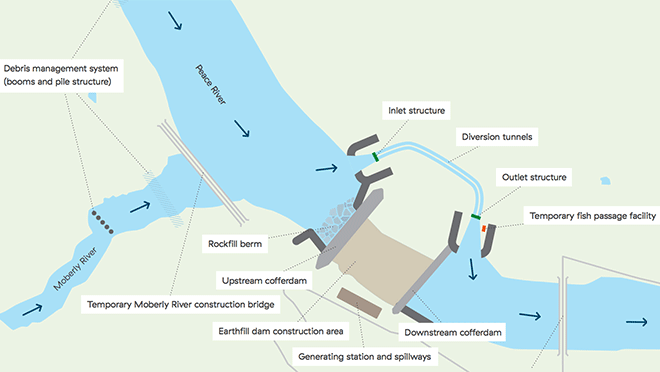Big rock stars in diversion of river for Site C project

Two tunnels and boulders work in tandem to free up area for dam construction
When you're trying to convince a river to change its course, you need really big rocks. Boulders up to the size of a small car – envision a pile of Fiats or Minis – are required to divert a river that can push up to 3,000 cubic metres of water per second.
Everything about the Site C Clean Energy project is big, and the rocks used in the diversion of the Peace River, which starts this month, are no exception. Once water starts flowing through two diversion tunnels, the rocks will be piled for several weeks until they block enough water from the main channel to allow for construction of what's known as a cofferdam to force all flow through the tunnels.
"It's called the upstream rockfill berm, because it's a berm full of rocks – engineers are awful at naming things," says Chris Hatton, Site C project manager, with a laugh. "That rock is, at minimum, one and a half metres by one and a half metres, by one and a half metres in volume. We place those into the river, and because they're massive, they don't get washed downstream."
Caterpillar 773 dump trucks, among the workhorses of choice at Site C, are capable of carrying only one or two of these rocks at a time. The work is timed to coincide with the lowest water flows of the year, and low flows will be guaranteed as the Peace Canyon dam upstream will reduce its generation to let less water through the dam's turbines.
Behind that rockfill berm, which will need to be at least four metres high, construction will start on a cofferdam, 16 metres high at the deepest part of the river channel. The upstream cofferdam, combined with a cofferdam downstream of the dam work area, will completely seal off river flow in the main channel.
"For a four-metre tall mini dam, the low flows of September are no big deal," says Hatton. "But when the waters rise, the water will go up and over that rockfill berm, which isn't watertight anyway. Our taller cofferdam will seal off the river so work on the earthfill dam can begin."
Once complete, the Site C dam will be more than 1,000 metres wide, 60 metres tall and 500 metres thick at its base. The third dam and power station on the Peace River, Site C will produce about 5,100 gigawatt hours (GWh) of electricity each year — enough energy to power the equivalent of about 450,000 homes per year in B.C. Because of its location, the power station will generate about 35 per cent of the energy produced at W.A.C. Bennett Dam – the first dam built on the Peace River – with only five per cent of the reservoir area.
Watch the two videos below for deep dives into the steps involved in river diversion at Site C.
Debris will be caught upstream, and migrating fish transported above the dam site
Throughout the dam's construction, water in the Peace River will flow through two large diversion tunnels, about 750 metres long and 11 metres in diameter, built into rock on the north bank of the river. To decrease the potential for logs and other debris to block the tunnel, debris management systems on the Peace River and Moberly River above the dam site have been set up.
BC Hydro is also building a temporary upstream fish passage facility that will operate throughout river diversion so that fish can continue to migrate upstream to spawn along the Peace River and its tributaries. Migratory fish are naturally attracted to fast-flowing water, so the passage is being built at the outlet of the diversion tunnels, where fish will be attracted to the high flows – too strong for them to navigate through – exiting the tunnels.
Fish will be sorted and migratory fish transported by truck above the dam site. A permanent version of this fish passage will be built once the dam is completed.